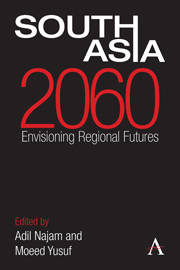Book contents
- Frontmatter
- Contents
- Acknowledgments
- List of Abbreviations
- Introduction: Imagining South Asian Futures
- Section I South Asia as a Region
- Section II State Relations
- Chapter 6 The Future of Democracy
- Chapter 7 Conflict and Reconciliation: Three Scenarios
- Chapter 8 Religion and State Formation
- Chapter 9 Will South Asia Still Be Terrorism's Center of Gravity?
- Chapter 10 Speculations on Nuclear South Asia
- Chapter 11 Nuclear Risk: Overstated or Underrated?
- Chapter 12 The Shadow of the India–Pakistan Stalemate
- Chapter 13 Regional Integration
- Chapter 14 The Future of Integration
- Chapter 15 The Giant Neighbor: Why is China Important?
- Section III Development
- Section IV Human Well-Being
- About the Authors
- Bibliography
- Index
Chapter 13 - Regional Integration
from Section II - State Relations
Published online by Cambridge University Press: 05 September 2013
- Frontmatter
- Contents
- Acknowledgments
- List of Abbreviations
- Introduction: Imagining South Asian Futures
- Section I South Asia as a Region
- Section II State Relations
- Chapter 6 The Future of Democracy
- Chapter 7 Conflict and Reconciliation: Three Scenarios
- Chapter 8 Religion and State Formation
- Chapter 9 Will South Asia Still Be Terrorism's Center of Gravity?
- Chapter 10 Speculations on Nuclear South Asia
- Chapter 11 Nuclear Risk: Overstated or Underrated?
- Chapter 12 The Shadow of the India–Pakistan Stalemate
- Chapter 13 Regional Integration
- Chapter 14 The Future of Integration
- Chapter 15 The Giant Neighbor: Why is China Important?
- Section III Development
- Section IV Human Well-Being
- About the Authors
- Bibliography
- Index
Summary
It has been almost three decades since the South Asian Association for Regional Cooperation (SAARC) was founded as an economic and political organization with lofty vision and far-reaching objectives. Unfortunately, little has been achieved through this body ever since. Today, South Asia is possibly the least integrated region in the world. The failure is neither because of the lack of potential nor because the countries are unable to recognize the vast opportunities that regional integration offers. Rather, this failure can be attributed to the lack of willingness on the part of the regional states to strive for the collective good of the region as a whole. Instead, they have unduly focused on bilateral differences created as a result of conflicts amongst specific countries, and, more recently, on the lack of collective efforts to combat terrorist movements. This chapter makes the argument that SAARC needs to shift its focus on the collective good of the region as a whole and lays out some of the ways in which it can do so.
Capitalizing on the Opportunities
The challenge, in many ways, is to turn South Asia into a cohesive region that identifies with and works towards collective regional prosperity. Recent economic and social developments in the SAARC region present an opportunity that the leaders of the region need to tap if they are serious about improving the lives of its 1.5 billion people. South Asia has experienced a period of robust economic growth of about 6 percent annually since 2000 resulting in significant progress in human development. The concern lies in the fact that this growth has not been a balanced regional growth.
- Type
- Chapter
- Information
- South Asia 2060Envisioning Regional Futures, pp. 102 - 107Publisher: Anthem PressPrint publication year: 2013

